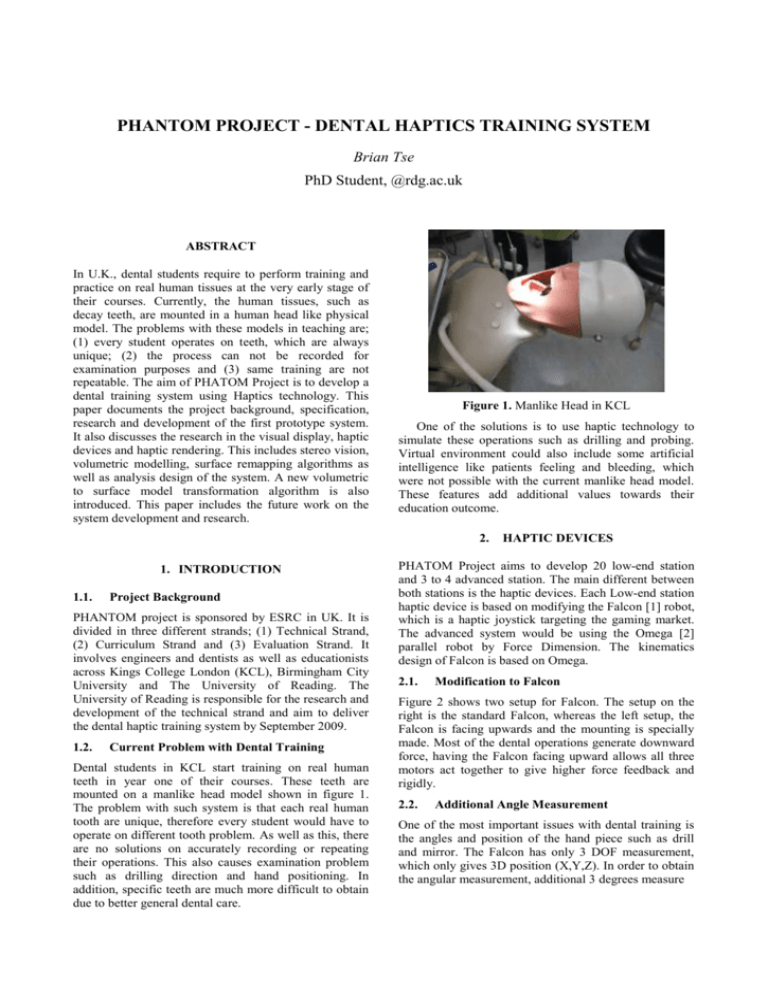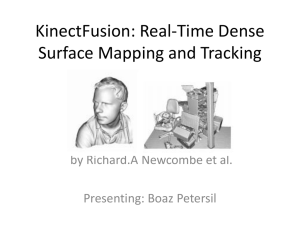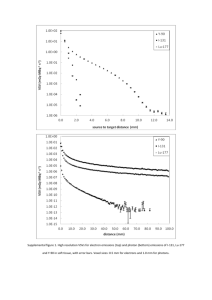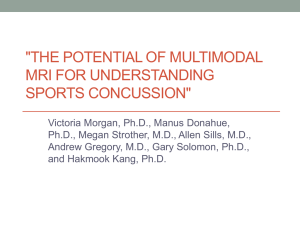Text - CentAUR - University of Reading
advertisement

PHANTOM PROJECT - DENTAL HAPTICS TRAINING SYSTEM Brian Tse PhD Student, @rdg.ac.uk ABSTRACT In U.K., dental students require to perform training and practice on real human tissues at the very early stage of their courses. Currently, the human tissues, such as decay teeth, are mounted in a human head like physical model. The problems with these models in teaching are; (1) every student operates on teeth, which are always unique; (2) the process can not be recorded for examination purposes and (3) same training are not repeatable. The aim of PHATOM Project is to develop a dental training system using Haptics technology. This paper documents the project background, specification, research and development of the first prototype system. It also discusses the research in the visual display, haptic devices and haptic rendering. This includes stereo vision, volumetric modelling, surface remapping algorithms as well as analysis design of the system. A new volumetric to surface model transformation algorithm is also introduced. This paper includes the future work on the system development and research. Figure 1. Manlike Head in KCL One of the solutions is to use haptic technology to simulate these operations such as drilling and probing. Virtual environment could also include some artificial intelligence like patients feeling and bleeding, which were not possible with the current manlike head model. These features add additional values towards their education outcome. 2. 1. INTRODUCTION 1.1. Project Background PHANTOM project is sponsored by ESRC in UK. It is divided in three different strands; (1) Technical Strand, (2) Curriculum Strand and (3) Evaluation Strand. It involves engineers and dentists as well as educationists across Kings College London (KCL), Birmingham City University and The University of Reading. The University of Reading is responsible for the research and development of the technical strand and aim to deliver the dental haptic training system by September 2009. 1.2. Current Problem with Dental Training Dental students in KCL start training on real human teeth in year one of their courses. These teeth are mounted on a manlike head model shown in figure 1. The problem with such system is that each real human tooth are unique, therefore every student would have to operate on different tooth problem. As well as this, there are no solutions on accurately recording or repeating their operations. This also causes examination problem such as drilling direction and hand positioning. In addition, specific teeth are much more difficult to obtain due to better general dental care. HAPTIC DEVICES PHATOM Project aims to develop 20 low-end station and 3 to 4 advanced station. The main different between both stations is the haptic devices. Each Low-end station haptic device is based on modifying the Falcon [1] robot, which is a haptic joystick targeting the gaming market. The advanced system would be using the Omega [2] parallel robot by Force Dimension. The kinematics design of Falcon is based on Omega. 2.1. Modification to Falcon Figure 2 shows two setup for Falcon. The setup on the right is the standard Falcon, whereas the left setup, the Falcon is facing upwards and the mounting is specially made. Most of the dental operations generate downward force, having the Falcon facing upward allows all three motors act together to give higher force feedback and rigidly. 2.2. Additional Angle Measurement One of the most important issues with dental training is the angles and position of the hand piece such as drill and mirror. The Falcon has only 3 DOF measurement, which only gives 3D position (X,Y,Z). In order to obtain the angular measurement, additional 3 degrees measure 3. VISUAL DISPLAY Figure 2. Right – Falcon standard setup, Left – Modify upward setup for better force response. is needed. The 3 axis would need to be intercept with each other because of the force transition. The first solution is to design a gimbal with 3 encoders (Figure 3). The 45 degrees offset is to avoid singularity problem with most dental position. This design suffers a major problem, which is the dentist finger resting position. Dental drilling finger resting position is around 5 to 8mm to the drill head. One of the dentist requirements is to have 3D stereo vision. This allows the tools to be position much more quickly and more accurate depth perception. Traditional red/blue eye image filter is not an option in this project due to the importance of colour. Using CRT monitor alongside with shutter glasses is a possible solution, but the limited availability of CRT and the eye tiredness caused by such system make it very difficult. Other option such as Head Mounted Display (HMD) is also not feasible as the current viewing angle and resolution is limited. Currently, the only options are to use multiprojector system or LCD 3D display. Both of these technology are based on either linear polarization or circular polarization. 3.1. Polarization Polarization is an electromagnetic wave property that describes the orientation and direction of the electric field oscillation. Absorptive or beam split polarizer is used to allow light to be polarized in certain way. Polaroid film and elongated silver nano-particles are the most common materials of adsorptive polarizer, which includes application such as LCD and 3D polarized glasses. Circular and linear polarizations are the two main polarization techniques used in nowadays LCD or projector based 3D display. 3.1.1. Figure 3. First Design of Angle Mesurement Gimbal Linear and Circular Polarization When the electromagnetic wave is linearly polarized, the vector of the electric field oscillation is happening along a straight line. The two most commonly used linear polarizations are horizontal and vertical. They are very widely used in LCD display. There are other common directions of linear polarization such as 45 and 135 degrees. Figure 4. 6 Encoders Base Angle Measurement Gimbal Due to the limited distance and the importance of the finger resting positing, Encoders would have to be mounted at the back and the gimbal would require to be much smaller. This initial prototype is shown in figure 4. This design involve the angle measurement is taken from the back of the drill instead of the front. This design would require 6 encoders. Three of the encoders would calculate out the position and the other three would be the angle. These angles are matched with the Falcon. Figure 5. Creating a circular polarization from single linear polarixzation using birefringent materials. Circular polarization works very differently with linearly polarization. Circular polarization consists of 2 linearly polarized waves; both waves are 90 degree out of phase with each other and have equal amplitudes and wavelength. The direction of the electric field oscillate of one wave is perpendicular to the other wave. The resulting electric wave is a helix shape along the wave propagation [3]. For example, one horizontal linear wave and one 90 degree out of phase vertical linear wave together creates a circular polarised wave (Figure 5). Due to the wave propagation, the wave can either be a lead or lag wave with respect to other one. This makes circular polarization to be either clockwise or anticlockwise. 3.2. 3D Display Up to the time of this paper published, three different 3D displays has been researched and tested. Figure 6 shows a side view of the 3D display called Planar. It consists of 2 AMLCD display and a 50/50 mirror between. The top AMLCD is horizontally-linear polarized and the lower AMLCD is vertically-linear polarized. The 50/50 mirror would reflect 50% of light intensity from both the top and bottom screen. User would require wearing 3D glasses, which left eye is polarized horizontally and right eye is polarized vertically. Therefore, one LCD image would only enter one of the users eye, resulting a stereo vision. Figure 6. Planar Side View The second 3D display is the Zalman. Unlike the Planar, Zalman uses circular polarization and only have one screen. The idea is that each row of pixel is circularly polarized in opposite direction. The odd number of pixel row is clockwise direction and the even number of pixel row is anti-clockwise direction. The pixel grid in the other word is horizontally interlaced. It is a common but expansive method of creating stereo image. User would require wearing circular polarised glasses. The main advantages of using Planar are the high quality image and viewing angles. Users get full LCD resolution with Planar whereas only half of the resolution with Zalman. The problem with Planar is that it loses it stereo vision if user head movement rotates along their viewing axis. On the other hand, Zalman uses circular polarization which does not suffer this problem. The third 3D display system is using two projectors with circular polarizer. One projector has clockwise polarizer and other one has anti-clockwise polarizer. Circular polarised glasses are required for user. This system would give us high quality image without suffering rotational problem like the planar. The difficulty is the installing of the projectors, calibrations as well as prices. 4. HAPTIC RENDERING Dental operations such as drilling, polishing and reduce tongue movement by mirror involve materials removals or shape modification. In order to develop realistic training system, the virtual mouth model would require being both interactive mathematically and visually dynamic. 4.1. Model Construction 4.1.1. Surface Deformation Model [4] uses surfacing deformation methodology to simulate drilling both haptically and graphically. The virtual mouth model is a triangle mesh surface model generated from laser scans. There are three interaction status associate with the model. (1) Separation Status refers to the tools not contacting any object in the scene. (2) Contact Status refers to the tools just contact the surface model without exceeding the force threshold. (3) Cutting/Drilling Status refers to the force applying on the surface model is greater than the force threshold, material removals start operate and deformation of the surface model starts happening. The triangle mesh is generated with information such as density and tissue type. The deformation of the triangle mesh is done by dividing the triangle in the mesh into higher number of triangles. Graphically, the update rate is around 15 to 20Hz, whereas the haptic update rate is around 1kHz. In order to determine the amount of deformation, local surface model is generated at each time loop and remap both the global model and the local model. Using pure surface model could result in haptic discontinuity; complex shape would result in high computation time for high number polygon collision detection. Most importantly, the resolution of the surface mesh requires to be high due to the drill size. 4.1.2. Hybrid Data Structure using Volumetric and Surface Modelling [5-12] uses both surface and volume mouth model. Similar to [4], when the tools are in contact status, the haptic force feedback is generated from the surface model. The key difference is that the haptic simulations of material removal are rendered via the volumetric model. Every simulation loop, volumetric data is required to be converted to surface mesh for contact status use. This gives a more realistic force feedback in situation where the shapes of the object are complex. The graphical rendering is updated at 15-30hz whereas the haptic is updated at least 1kHz. If using only the volume model as the haptic contact rendering, the force feedback become very discontinue and extreme rough texture (Figure 7). The key challenge in using hybrid data structure is the speed of the volume to surface remapping. In the other word, the transition model between the drilling status and the contact status. Converting the volume data back to surface model allow smooth surface haptics when the tools are in contact status. 4.2. Surface Remapping Our system uses voxel volume model for haptic drilling or material removal. To solve the conversion problem from volume to surface model, it generates majority of the data before the simulation is started. These data would be stored directly into memory for fast and efficient processing. The conversion algorithm uses these data to remap the surface in every haptic simulation time loop. 4.2.1. Figure 7. Haptic Rendering on Surface Mesh and Volume Model [11] introduces a novel methods for solving the problem with conversion speed from volume to surface model. Their method uses an intermediate surface smoothing transition model while drilling. When drilling is operated, the drill head is represented as a sphere. The amount to be removed is the target model and it is constructed using CSG method. While drilling, user can only feel the shape of the drill head (target model) in the drilling direction. Once the drill head not touching particular parts of surface, these surfaces would be mapped with the CSG data and produces a high graphic quality surface, ready for next contact status. CSG is standard 3D graphic operations; it allows fast and accurate surface reconstruction without heavy computation. Figure 8 shows drilling direction and the target model update process. Data Structure – Voxel Cube Array When the system is initiated, a voxel cube array would be generated. Each voxel is an object created from the class Voxel. The voxel cube array stores the volume model as a array of voxel object. Table 1 shows the information stored on each voxel object. Table 1. Voxel Object Object Data Information Position N1…N6 Density Colour Hardness Friction X,Y,Z Neighbour Voxel memory address Tissues density Tissues Colour Reaction force for robot Friction of that voxel N1 to N6 record the 6 neighbour voxel location of the current voxel object. This is shown in figure 9. The volume model are setup in a specific way so that their neighbour 1 voxel is always in the same directions. Figure 9. Neighbour (N) Voxel direction 4.2.2. Figure 8. Relationship between the Target Model and Haptic Rendering. Other surface remapping methods includes marching cubes [10,12]. Marching cube algorithm basically uses voxel to extract the polygon mesh out of a volume model. The idea is that the algorithm would generate a number of unique cubes, which has different gradients of scalar field, and interpolate these unique cubes with the volume model. General algorithm uses 15 unique cubes, which create 256 cube configurations due to the rotation of each 15 cubes. The results surface mesh is polygon based. The downside of this method is the possibility of rough surface finish and haptic discontinuity Data Structure – Surface Array By knowing exactly where each voxel is and what other voxel is surrounding it, the system can then extract the voxels which are on the surface of the volume model very quickly based on the voxel condition. For example, if the 12th voxel has an empty field in N4, the system would then know that 12th voxel is a surface voxel, with side 4 as part of the model surface. Surface Array is an array of pointers which points to the memory address of the surface voxel inside the Voxel Cube Array. 4.2.3. Conversion Algorithm Both Voxel Cube Array and Surface Array are generated while the simulation system is initiating. When the drilling haptic rendering is operated, the conversion algorithm is constantly altering the data inside the Surface Array based on the information given from the Voxel Cube Array. The important issues with volume to surface conversion are: (1) Speed, the conversion must be done without searching, all algorithmetic operations must be done by direct indexing; (2) Triangle vertices direction. All triangle must be build in either clockwise or anti clockwise directions because of the normal vector direction; (3) The surface array can only be gone through once only. [6] Dan Morris, Christopher Sewell, Nikolas Blevins, Federico Barbagli, Kenneth Salisbury, “A Collaborative Virtual Environment for the Simulation of Tempral Bone Surgery”. http://ai.stanford.edu/~csewell/research (2004). The algorithm first start at the top of the Surface Array, build the triangle in anti-clockwise direction. The Voxel Cube Array provide all the neighbouring information so there is no need for searching. When all possible triangles associate with that voxel are built, that particular voxel in Surface Array is changed as built, and the algorithm then would not try to build any triangle with this voxel. [8] Wu Xiaojun, Liu Weijun, Wang Tianran, “A New Method on Converting polygonal Meshes to Volumetric Datasets”. IEEE (2003). Adding or removing a new item in an array takes up more processing power than editing an existing array data. In the algorithm, dummy array spaces are present. If one surface voxel is to be removed from the scene, the dummy array spaces are there ready for the system to edit it to new surface node. The voxel removed from the scene would be marked as no neighbour in the Surface Array. The algorithm would does not remove that particular voxel pointer in the Surface Array until the user stops drilling. The whole process does not involve any searching because the algorithm has all the knowledge on the voxel. [10] I. Marras, L. Papaleontiou, N. Nikolaidis, K. lyroudia and I. Pitas, “Virtual Dental Patient: A System For Virtual Teeth Drilling”. IEEE (2006) 5. CONCLUSION AND FUTURE WORK The conversion algorithm is currently under additional research and development. Majority of the works currently on hardware research, focusing on solving some of the vision and hand collocation problem. Both Planar and Zalman monitor has been tested by dentist from KCL on the 9th July 2008. The questionnaire results clearly show that Planar is much better than Zalman mainly because of the viewing angle and image quality. Acknowledgement: Thank you to Alistair Barrow and William Harwin. 6. REFERENCES [1] Novit Falcon, http://home.novint.com/. [2] Omega, http://www.forcedimension.com/ [3] Qiansuo Yang, “Numerical analysis of a dual polarization mode-locked laser with a quarter wave plate”. http://www.sciencedirect.com/ (2004). [4] Daniel Wang, “Cutting on Triangle Mesh: Local Model-Based Haptic Display for Dental Preparation Surgery Simulation”. IEEE Nov/Dec 2005. [5] Andreas Petersik, Bernhard Pflesser, Ulf Tiede, Karl-Heinz Hohne, “Realistic Haptic Interaction in Volume Sculpting for Surgery Simulation”. http://citeseer.ist.psu.edu/587419.html (2003). [7] K C Hui, H C Leung, “Virtual Sculpting and Deformable Volume Modelling”. http://www.cuhk.edu.hk (2002). [9] Marco Agus, Andrea Giachetti, Enrico Gobbetti, Gianluigi Zanetti, Antonio Zorcolo, “Adaptive techniques for Real-Time haptic and visual simulation of bone dissection”. IEEE (2003). [11] Laehyun Kim, Yoha Hwang, Se Hyung Park and Sungdo Ha, “Dental Training System using Multimodal interface”. http://www.cadanda.com (2005). [12] XJ He, YH Chen, “Bone drilling simulation based on six degree-of-freedom haptic rendering”. www.eurohaptics.vision.ee.ethz.ch/2001/ (2001).








